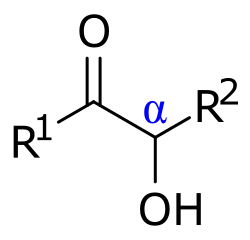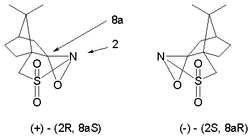Chemistry:Acyloin

In organic chemistry, acyloins or α-hydroxy ketones[1] are a class of organic compounds of the general form R–C(=O)–CR'(OH)–R", composed of a hydroxy group (–OH) adjacent to a ketone group (>C=O). The name acyloin is derived from the fact that they are formally derived from reductive coupling of carboxylic acyl groups (R–C(=O)–).[1] They are one of the two main classes of hydroxy ketones, distinguished by the position of the hydroxy group relative to the ketone; in this form, the hydroxy is on the alpha carbon, explaining the secondary name of α-hydroxy ketone.
Synthesis
Classic organic reactions exist for the synthesis of acyloins.
- The acyloin condensation is a reductive coupling of esters
- The benzoin condensation is condensation reaction between aldehydes catalyzed by a nucleophile
- Oxidation of carbonyls is possible with molecular oxygen but not selective
- Better alternative is oxidation of corresponding silyl enol ethers with mCPBA in the Rubottom oxidation
- MoOPH oxidation of carbonyls is a system with molybdenum peroxide, pyridine and hexamethylphosphoramide.
Enolate oxidation by sulfonyloxaziridines
Enolates can be oxidized by sulfonyloxaziridines.[2][3] The enolate reacts by nucleophilic displacement at the electron deficient oxygen of the oxaziridine ring.
This reaction type is extended to asymmetric synthesis by the use of chiral oxaziridines derived from camphor (camphorsulfonyl oxaziridine). Each isomer gives exclusive access to one of the two possible enantiomers. This modification is applied in the Holton taxol total synthesis.
In the enolate oxidation of the cyclopentaenone below[4] with either camphor enantiomer, the trans isomer is obtained because access for the hydroxyl group in the cis position is limited. The use of the standard oxaziridine did not result in an acyloin.
Reactions
- Reduction of acyloins give diols.
- Oxidation of acyloins give diones.
- α-hydroxy ketones give positive Tollens' and Fehling's test.
- Some acyloins rearrange with positions swapped under the influence of base in the Lobry–de Bruyn–van Ekenstein transformation
- A similar reaction is the so-called Voigt amination[5] where an acyloin reacts with a primary amine and phosphorus pentoxide to an α-keto amine:[6]
- Indole synthesis,[7] compare Bischler–Möhlau
See also
- Glycolaldehyde, a related molecule equivalent to an acyloin with both R groups as hydrogen (and thus an aldehyde not a ketone)
References
- ↑ 1.0 1.1 IUPAC, Compendium of Chemical Terminology, 2nd ed. (the "Gold Book") (1997). Online corrected version: (2006–) "acyloins". doi:10.1351/goldbook.A00126
- ↑ Davis, Franklin A.; Vishwakarma, Lal C.; Billmers, Joanne G.; Finn, John (1984). "Synthesis of α-hydroxycarbonyl compounds (acyloins): direct oxidation of enolates using 2-sulfonyloxaziridines". J. Org. Chem. 49 (17): 3241–3243. doi:10.1021/jo00191a048.
- ↑ Davis, F. A.; Haque, M. S.; Ulatowski, T. G.; Towson, J. C. (1986). "Asymmetric oxidation of ester and amide enolates using new (camphorylsulfonyl)oxaziridines". J. Org. Chem. 51 (12): 2402. doi:10.1021/jo00362a053.
- ↑ 4.0 4.1 Hughes, Chambers C.; Miller, Aubry K.; Trauner, Dirk (2005). "An Electrochemical Approach to the Guanacastepenes". Org. Lett. 7 (16): 3425–3428. doi:10.1021/ol047387l. PMID 16048308. http://www.cchem.berkeley.edu/trngrp/traunerweb/Publications/electrochemical.pdf.
- ↑ von Meyer, E.; Voigt, Karl (1886). "Ueber die Einwirkung von primären aromatischen Aminen auf Benzoïn" (in German). J. Prakt. Chem. 34 (1): 1–27. doi:10.1002/prac.18860340101. https://zenodo.org/record/1427912.
- ↑ Lawrence, Stephen A. (2004). Amines: Synthesis, Properties and Applications. Cambridge University Press. ISBN 978-0-521-78284-5.
- ↑ Roth, Lepke (1972). "Synthese von Indol- und Carbazol-Derivaten aus α-Hydroxyketonen und aromatischen Aminen" (in German). Archiv der Pharmazie 305 (3): 159–171. doi:10.1002/ardp.19723050302. PMID 5048240.
 |


![Enolate oxidation example[4]](/wiki/images/thumb/0/02/Acyloin_example_Hughes.png/500px-Acyloin_example_Hughes.png)


